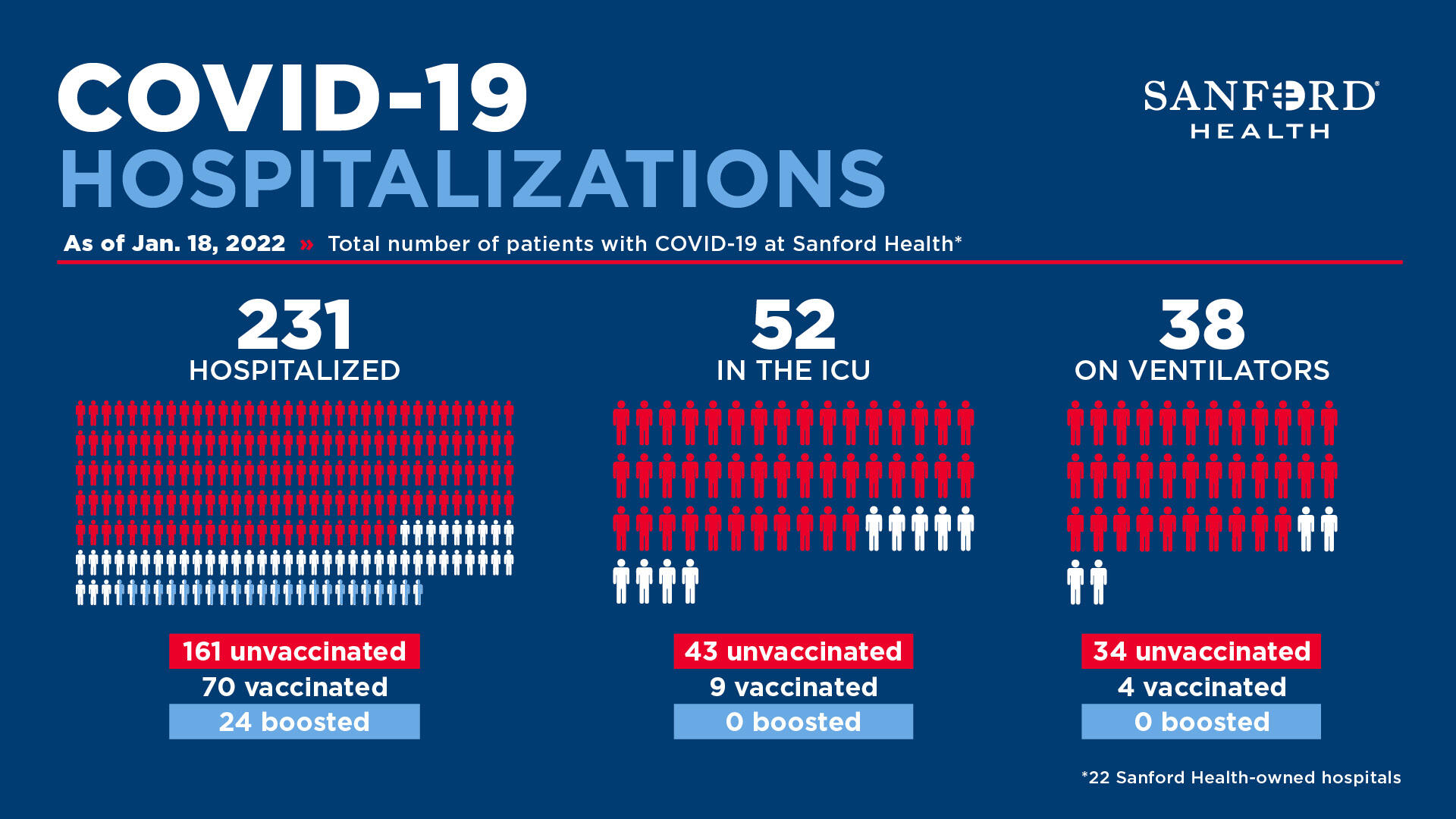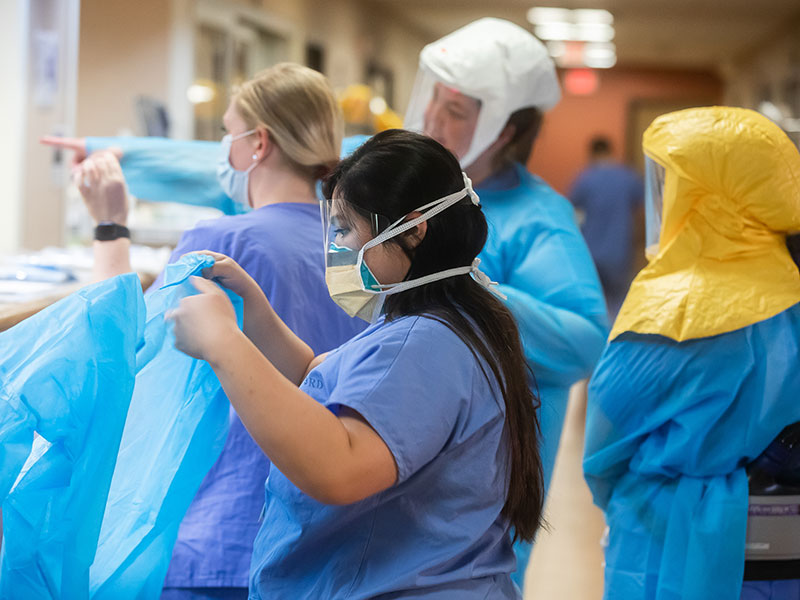Unfortunately, the coronavirus didn’t disappear with a new year.
In fact, the new year brings new record case numbers and hospitalizations for Sanford Health patients and communities.
According to this dashboard from the Washington Post Jan. 19, more than 852,000 people have died and more than 68.2 million people have been infected in the United States.
But those numbers don’t tell the full story as the omicron variant is hitting communities everywhere with an impact to hospitals, businesses and schools unlike previous coronavirus surges.
“We’re not at the peak of what this virus can do,” Chief Physician Jeremy Cauwels, M.D., said in a Jan. 18 Facebook Live Q&A with Sanford Health News.
Watch: Facebook Live Q&A Jan. 18
Reviewing data from the coasts, Great Britain and South Africa, he said things will likely get worse before they get better.
“We are going to see more people out of work, more people having difficulty with this virus who will end up in the hospital.”
Omicron’s ‘overwhelming’ impact to hospital system
Few are feeling the impact of omicron variant in January more than hospital systems. While the data shows the omicron variant does not result in sicker patients, the rate of transmission is making more people sick — and quickly.
As of Jan. 18, 40% — or 4 out of every 10 people — testing at Sanford Health are positive with COVID-19.
Some of those people are Sanford employees who are out of work for at least five days, further straining the system.
“The fatigue that we’re having right now is certainly creating a lot more pressure than it did before,” chief nursing officer Erica DeBoer said.
“So, we’re having to look at every single process, every single solution that we put in place and make sure that is the most essential work that we need to be doing to care for the patients who need us right now.”
She said leaders on the corporate side and the clinical side are “doubling down” on solutions supporting mental health as they work to help hospital and clinic staff wherever they’re needed most.
The good news with this surge, according to Dr. Cauwels, is hospitals are seeing case numbers and hospitalizations move at different rates for the first time ever. The difference is either because more individuals are vaccinated or this variant is causing less serious illness than previous variants, he said.
The bad news: Omicron is still incredibly infectious.
What it means to be fully vaccinated
According to the latest CDC guidelines, individuals with a booster dose of the COVID-19 vaccine are considered fully vaccinated.
Booster doses are now authorized for kids 12 and older.
After the primary vaccine series, everyone 12 and older should get boosters as follows:
- Wait 5 months after mRNA vaccines Pfizer and Moderna
- Wait 2 months after Johnson & Johnson
Every week, Sanford Health releases an infographic showing the number of people who are vaccinated versus unvaccinated patients hospitalized in Sanford facilities, in the intensive care unit (ICU) and on ventilators.
An update to those infographics now includes patients who have received their booster dose.
Enlarge

Infographic by Sanford Health
“We’re now adding that to be transparent about our data,” Dr. Cauwels said.
As the graphic shows, none of the patients in the ICU or on a ventilator have received their booster dose.
“There are a few boosted patients in our hospital,” he said. “But if you want to know why the booster is so important, it’s to prevent that severe illness. That’s why we recommend the booster. That’s why we recommended the initial series.”
Learn more: COVID vaccine boosters available at Sanford Health
Yes, the COVID-19 vaccine is still effective.
It may not be enough to prevent a breakthrough COVID infection with the highly infectious omicron variant, but it is still extremely effective at preventing serious illness and death from the virus.
“(The COVID vaccine) wasn’t to spare you from ever getting sick,” Dr. Cauwels added. “It was to make sure that you wouldn’t get severely ill and that booster is doing that job very nicely – both nationwide and locally.”
Positive COVID rates outrun vaccination rates in kids 5+
Tracie Newman, M.D., a pediatrician in Fargo, is concerned with the number of children currently in the hospital with COVID-19 in North Dakota.
“It’s challenging,” Dr. Newman told Sanford Health News. “There is a lot of misinformation around both COVID-19 in children and the vaccine in particular.”
Dr. Newman worries about the complications for kids with COVID-19, the multisystem inflammatory syndrome (MIS-C), long-term effects from the virus and further disruption to children’s lives.
On Jan. 13, the American Academy of Pediatrics reported child COVID-19 cases among children have spiked dramatically across the United States.
The past week nearly 1 million cases were reported, four times the rate of the peak of last winter’s surge. For the week ending Jan. 13, over 981,000 child COVID-19 cases were reported. This number is a 69% increase over the 580,000 added cases reported the week ending Jan. 6 and a tripling of case counts from the two weeks prior.
Children continue to make up around 17.3% of all cases, and this proportion has increased over time.
In early January, Sanford Health was caring for around 10 kids in the hospital at a time with COVID’s omicron variant.
“That sounds like a small number, and thankfully it is a small number, but there are very few illnesses we see that cause a block of kids to get sick and hospitalized in our system,” Dr. Cauwels said. “We will see kids get sick from influenza or RSV and be hospitalized three or four at a time. But to see 10 kids or more with the same illness is extremely unusual.
“This is a serious offender in what doesn’t allow kids to be healthy anymore. If you have the option to protect your children, please do so.”
The COVID-19 vaccine is available for children age 5 and up. Vaccines for children age 6 months and up may be authorized next. Clinical trials are underway for children age 6 months to 4 years old.
Back to COVID prevention basics
It’s a lot easier in 2022 to know if you’re positive for COVID-19 with the launch of self-test kits.
They can be found online, at drug stores, in airports and are being shipped to homes via state and federal governments.
As transmission rates increase, if you are feeling sick, stay home.
Common symptoms of omicron include congestion, fever, runny nose, sore throat and body aches.
Read: What to do if you think you need a COVID-19 test
Dr. Cauwels said if you’re showing symptoms and test positive at home, you likely have COVID-19, and additional testing isn’t necessary.
“It’s accurate enough that if you have symptoms, stay home and isolate yourself from family members,” he said.
If you feel better after day five, the CDC suggests you can resume normal activities by wearing a mask.
If you’ve been exposed to COVID-19, you’re recommended to mask in public and test at home after a few days to ensure you’re not walking around exposing others.
If you’re experiencing difficulty with COVID-19 symptoms, contact your provider, and learn more about COVID-19 care at Sanford Health.
Information in this story was accurate when it was posted. As the COVID-19 pandemic changes, scientific understanding and guidelines may have changed since the original publication date.
More information
- As COVID testing options increase, communication should too
- Booster dose builds immunity as omicron variant spreads
- Which type of mask is best? Ask an infectious disease doctor
…
Posted In COVID-19, Expert Q&A

